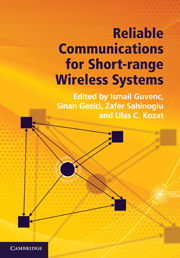Book contents
- Frontmatter
- Contents
- List of contributors
- 1 Short-range wireless communications and reliability
- Part I High-rate systems
- 2 High-rate UWB and 60 GHz communications
- 3 Channel estimation for high-rate systems
- 4 Adaptive modulation and coding for high-rate systems
- 5 MIMO techniques for high-rate communications
- Part II Low-rate systems
- Part II Selected topics for improved reliability
- Index
2 - High-rate UWB and 60 GHz communications
from Part I - High-rate systems
Published online by Cambridge University Press: 01 June 2011
- Frontmatter
- Contents
- List of contributors
- 1 Short-range wireless communications and reliability
- Part I High-rate systems
- 2 High-rate UWB and 60 GHz communications
- 3 Channel estimation for high-rate systems
- 4 Adaptive modulation and coding for high-rate systems
- 5 MIMO techniques for high-rate communications
- Part II Low-rate systems
- Part II Selected topics for improved reliability
- Index
Summary
In this chapter, two technologies for high data-rate communications systems for wireless personal area networks (WPANs) are discussed. Namely, the ultrawideband (UWB) technology that operates in the 3.1–10.6 GHz band and the millimeter wave (MMW) technology (also called 60 GHz radio) that can use the 57–64 GHz band in most parts of the world are considered. First, a generic overview is given and various application scenarios are discussed. Then, the ECMA standard for high-rate UWB systems is studied. Finally, two standards for the 60 GHz MMW radio are investigated.
Overview and application scenarios
In order to realize high-speed communications systems with low power consumption, signals with very large bandwidths need to be employed. One way of designing such communications systems is to use UWB signals as an underlay technology by utilizing all or part of the frequency spectrum between 3.1 and 10.6 GHz [1–3]. According to the US Federal Communications Commission (FCC), a UWB signal is defined as having an absolute bandwidth of at least 500 MHz or a relative (fractional) bandwidth of larger than 20% [3–4].
In order not to cause any adverse effects on other wireless systems in the same frequency band, such as IEEE 802.11a wireless local area networks (WLANs), certain power emission limits are imposed on UWB devices by regulatory authorities, such as the FCC in the USA [3] and the Electronic Communications Committee (ECC) in Europe [5].
- Type
- Chapter
- Information
- Reliable Communications for Short-Range Wireless Systems , pp. 31 - 60Publisher: Cambridge University PressPrint publication year: 2011



